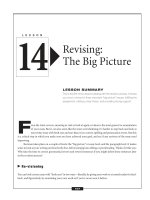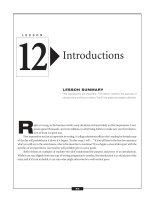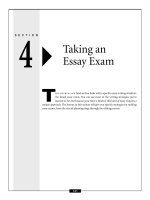Write Better Essays - Brainstorming Techniques - Freewriting and Listing
Bạn đang xem bản rút gọn của tài liệu. Xem và tải ngay bản đầy đủ của tài liệu tại đây (147.68 KB, 12 trang )
M
any students procrastinate when faced with essay assignments for the same reason—they
don’t know what to write about. This is especially true when students are free to select the topic.
Instead of feeling liberated, they find themselves wishing for specific direction. Nowhere is this
more critical than in a timed essay exam, when you have to choose a topic quickly in order to complete the exam
within 20 to 30 minutes. Fortunately, a few simple strategies can help you generate ideas for any essay assignment.
Brainstorming Ideas
How do you generate ideas? Some writers stare at a blank page waiting for inspiration, while others dive into a
draft hoping ideas will come as they write. Both of these techniques take time and often result in disappointment.
There are more productive ways to come up with material for your essay—both in terms of time spent and in the
quality of that material. Whether you are assigned a topic, must come up with one on your own, or are writing
under a time constraint, taking the time to focus and shape your thoughts will result in a better final product.
LESSON
Brainstorming
Techniques:
Freewriting
and Listing
LESSON SUMMARY
Even the most experienced writers sometimes have trouble coming up
with ideas. This lesson teaches you two important techniques for gen-
erating ideas.
3
31
■
Resist the temptation to look back at what you have written during the process.
■
If you can’t stay on topic, keep writing anything to maintain the flow.
■
Don’t censor yourself; no one will see your freewriting, so commit every thought to paper.
■
Follow your ideas wherever they lead you.
■
When finished, read your freewriting with a highlighter, noting the most interesting and strongest ideas.
■
Try the process again after you’ve focused your topic; more ideas may be generated.
Keys to Successful Freewriting
The most effective technique for focusing and shaping your thoughts is brainstorming—allowing yourself
some time to make connections with your subject, noting everything and anything that comes to mind. In this
lesson and the next, you’ll learn four specific strategies for brainstorming. They may be used both to generate new
ideas and to clarify those you already have. Brainstorming can also be used effectively when you are faced with a
number of possible essay topics and must determine which is the best vehicle to express your unique thoughts and
experiences. Some are better suited to a longer writing process, such as the college admissions essay, while others
may be adapted for when you have a shorter period to complete an essay, as with the SAT.
Freewriting
Freewriting is probably the best-known prewriting technique. It works well when you have some thoughts on a
topic, but can’t envision them as an essay. Freewriting also functions as a developmental tool, nurturing isolated
ideas into an essay-worthy one. People who use this technique often surprise themselves with what comes out on
paper. It is common to discover a thought or point you didn’t realize you had.
Specifically, freewriting means spending a predetermined period of time writing nonstop, focusing on a spe-
cific topic. In fact, freewriting should be called “flow writing,”because the most important aspect to this prewrit-
ing technique is the flow, or momentum, that comes when you stay with it. It works best when you write in full
sentences, but phrases are also effective. The key is to keep writing, without regard for grammar, spelling, or wor-
thiness of ideas. Your speed will help keep you from editing or discarding any ideas.
Freewriting Example
A student received the following essay assignment:
Adrienne Rich wrote: “Lying is done with words and also with silence.” Do you agree? Use your personal experience
and/or your observations to support your answer.
–BRAINSTORMING TECHNIQUES: FREEWRITING AND LISTING–
32
Here is the result of a short freewriting session:
Do I agree? I think so. Is it a lie if you don’t say something when you know something? Not technically, but it has
the same effect, doesn’t it? I remember when I saw Jay with someone else but I didn’t tell Karen. She never came
out and asked me if Jay was cheating on her, but I knew. But that’s not really a lie is it so what do you call it?
But there are more important cases where not telling the truth can be deadly. Like if you know someone is plan-
ning to commit a crime, and you don’t tell anyone. Didn’t someone go to jail for not telling the police she knew
about the Oklahoma City bombing before it happened? But that’s not a lie, it’s just not telling, so not telling is
not the same as lying. But it can have equally terrible consequences. I guess the point is that you know a truth
but you don’t reveal it. So they’re not the same but they do the same thing. People can get hurt. Unless you believe
what you don’t know won’t hurt you. But that probably falls into the same category as a white lie. It’s the other
lies and other silences that are the problem.
During her freewriting session, this student came up with a couple of examples and, through them, found
a tentative thesis for her essay. She also brought up some issues that will be central to her argument, including the
definition of a lie and whether people have a moral obligation to speak up when they have certain kinds of knowl-
edge. You can also see that the student has several run-on sentences, some repetition, and a very informal style.
That is part of the freewriting technique.
Practice 1
Using a separate sheet of paper or your computer, spend five minutes freewriting on the following essay assign-
ment. Remember, there is no wrong answer for this exercise as long as you address the topic. Keep your pen or
your typing fingers moving, don’t stop, and don’t edit or judge. Just set the timer for five minutes, and write.
In his essay “Urban Strategy,” William Rhoden describes a time that he put himself at risk to do what he thought was
right. Describe a time when you, like Rhoden, put yourself at risk (physically, socially, emotionally, academically) to
do what you thought was right. Was it worth the risk? Why or why not?
Listing
Listing is similar to freewriting in that it is a timed, flowing exercise meant to elicit many thoughts and ideas on
a given topic. However, instead of putting whole sentences or phrases on paper, this prewriting technique involves
creating a list. It might contain various individual thoughts, ideas that make sense in a particular order, and/or
ideas linked together by association with previous ideas.
Listing is a great brainstorming strategy for collaborative writing projects, which work best when they begin
with the entire group collecting ideas. In addition, unlike freewriting, listing works well in a timed writing situ-
ation. Even within the 25 minutes allotted for the SAT essay, spend a few minutes first listing your ideas before
beginning to write.
–BRAINSTORMING TECHNIQUES: FREEWRITING AND LISTING–
33
In this example, a student used listing to generate ideas for his college application essay.
In your opinion, what is the greatest challenge your generation will face? What ideas do you have for dealing with this
issue?
■
Being overwhelmed by technology
■
Staying in physically touch when everything becomes virtual
■
How will we know what’s real?
■
If people live longer, what about the generation gap?
■
Find better ways to take care of parents, and grandparents
■
Being overwhelmed by information
■
What about the people who don’t have access to technology—social inequality
■
The environment
■
Slow consumption of our resources
■
Recycle more
■
Come up with alternative fuel sources
■
World government?
■
Disease—new viruses—bird flu?
■
What about our new power for destruction, biowarfare?
Practice 2
Take three to five minutes to brainstorm a list of ideas for the following assignment:
Many forces contribute to our sense of self. What is a strong determining factor for your sense of identity?
34
■
If you are not already being timed, set a timer for at least 15 minutes (the more time you spend, the more
and better ideas you will probably come up with).
■
Write every word or phrase that comes to mind about your topic. If you have not selected a topic, write an
answer to the question(s), “What do I have to say to my audience?” or “What do I want my audience to know
about me?”
■
As with freewriting, do not edit or censor any ideas, and ignore the rules of spelling, grammar, and punctuation.
■
When you are finished, look over the list carefully. Cross out useless information, and organize what is left.
Categorize similar items.
How to Use Listing
In Short
Two effective ways to generate ideas are the freewriting and listing brainstorming techniques. Simply write non-
stop about your assignment for a set period of time, either going across the page in sentences (freewriting) or down
the page in a list (listing). Don’t judge your ideas, and don’t edit. The more freely you write, the easier it will be
to tap into your creativity—and the more ideas you’ll come up with.
–BRAINSTORMING TECHNIQUES: FREEWRITING AND LISTING–
35
Use the freewriting and listing techniques for any kind of writing or thinking tasks this week. For exam-
ple, if you have to buy a gift for a friend, brainstorm a list of ideas. Or, if you have to make an important
decision, freewrite about the pros and cons for five minutes.
Skill Building until Next Time









